System Dynamics
|
| < Day Day Up > |
|
As we’ve noted, the elements of systems do not work in isolation from each other. If you can take components away from a system without affecting its functioning and relationships, then you have a collection, not a system. A system, by definition requires that all elements be present in order for it to accomplish its goal.
Also, a system’s components must typically be arranged in a specific way for it to carry out its purpose, i.e., to provide the intended challenge to the players. If that arrangement is changed, the results of the interaction will change. Depending on the nature of the relationships in the system, the change in results may be unnoticeable, or it may be catastrophic, but there will be a change to some degree.
Let’s say that our example on page 111 of the ogre and the footman from WarCraft II was changed; instead of using the properties of basic damage, piercing damage and target’s armor to determine the range of potential damage from an attack, let’s assume the range for each unit was just a random number between 1 and 20. How would this change the outcome of each individual battle? How would it change the overall outcome of the game? What about the value of resources and upgrades?
If you said that the element of chance in the game would increase in both individual combat encounters and overall outcome, you are right. Also, the value of resources and the upgrades available via those resources would sink dramatically, since upgrades to units and armor would mean nothing in terms of determining outcome. The only strategy open to players in this game would be to build as many units as possible, as sheer numbers would still overwhelm in battle. So by changing the relationship between units in combat, we have changed the overall nature of the WarCraft II system.
Another important feature to understand about the interaction of systems is that systems are greater than the sum of their parts. By this we mean that studying all of the individual qualities of each system element in isolation does not equal studying these elements in relationship to each other. This is important for game designers to realize, as games can only be understood during play when their dynamics become evident.
Exactly how the dynamics of any given game system are affected by the properties, attributes and relationships of its objects is difficult to generalize. A good way to understand how these elements can affect each other is to look at some example systems—ranging from very simple to fairly complex—that exhibit various types of dynamic behavior.
Tic-tac-toe
The objects in tic-tac-toe are the spaces on the board. There are nine of them, and they are defined by their properties, behaviors, and relationships. For example, their properties, are “null,” “x” or “o.” Their relationships are defined by location. There is one center space, four corners and four sides. When the game begins, the relationship between the spaces is such that there are only three meaningful choices for the first player: center, corner or side.
The second player has between two or five meaningful choices—depending on where the first player put an “x.” You can see by the diagram of potential moves, that playing the first “x” in the center reduces the amount of significant next moves to 2. Playing the first “x” in a corner or on a side creates up to 5 next moves.
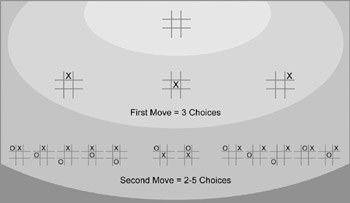
Figure 5.3: Partial tic-tac-toe game tree
If we continued this diagram of tic-tac-toe out to its conclusion, we would see that the “tree” of possibilities is not very large. In fact, once you learn the best possible moves to make, you can always win or tie at this game because of its ultimate simplicity. What is it about tic-tac-toe that makes its system so easy to learn?
First, we cans see that the game objects themselves are simple: they have only three properties and one behavior. Also, their relationships to each other are fixed: the locations of the spaces on the board do not change. Because of both the objects and their relationships, the system has only a few possible outcomes, and these are all fairly predictable. And as a result of its limited possibilities for play, tic-tac-toe tends to lose the interest of players once they learn the optimal moves for any given situation.
Chess
An example of a system that has more than one type of object, and more complex behaviors and relationships between objects is chess. First, let’s look at the objects in chess: there are six types of units, plus 64 unique spaces on the board.
Each unit has several properties: color, location, and value. For instance, the white queen has a value of nine[2] and a beginning location of D1 (the space at the intersection of the fourth rank of the first file). Alone, these properties do not make the objects in chess more complex than the spaces on the tic-tac-toe board. However, the varied behaviors of and relationships between the objects do make them more complex. Since each unit has specific behaviors in terms of movement and capture, and because those abilities create changes to their locations on the board, the relationships between each unit are effectively changed as a result of every move.
While it is theoretically possible to create a “tree” similar to the one we drew for the opening moves of tic-tac-toe, it quickly becomes clear that the complexity of potential outcomes beyond the first few moves makes this a useless and physically impossible process. This is not the way players tend to approach the game, and it’s not even the way that computer chess applications have been programmed to decide the best move.
Rather, both players and successful programs tend to use pattern recognition to solve problems, calling up solutions from memories of previously played games (or a database in the case of the computer), rather than plotting out an optimal solution for each move. This is because the elements of the game system, once set in motion, create such a large range of possible situations that the tree becomes too complex to be useful.
Why does chess have such a vast number of possible outcomes as opposed to tic-tac-toe? The answer lies in the combination of the simple, but varied, behaviors of the game objects and their changing relationships to each other on the board. Because of the extremely varied possibility set, chess remains challenging and interesting to players long after they have mastered its basic rule set.
One of the most important aspects of a game is the sense of “possibility” that is presented to the players at any given time. As we discussed in the previous chapter when talking about challenge, the goal of the designer is to present a situation that is equal to the abilities of the players, and yet grows in challenge over time with their abilities. It’s clear from the two examples that how a system is constructed dramatically changes the dynamics of that system over time and the range of possibilities that face the player at any given point.
The range and type of possibilities within the system is not a situation where “more is better” in all situations. Many successful games have a somewhat constrained set of possibilities, and yet still offer interesting gameplay. For example, a linear boardgame like Trivial Pursuit has very small possibility space in terms of outcome, but the overall challenge of the game is not affected by this. Some console games, like side-scrollers, have a similarly small range of possibilities: you either successfully navigate the challenge or you’re stuck. But this range of action works for these types of games. Story-based adventure games often have branching structures with a limited number of outcomes. For players of these games, navigating that defined set of possibilities is part of the challenge.
On the other hand, some new games are attempting to create larger and larger ranges of possibility for their systems. Simulation games (like The Sims), real-time strategy games, and massively multiplayer worlds, all use an approach to game systems that focuses on looser, changeable relationships between objects, along with less defined behaviors and goals. This tends to create a larger possibility space for the player and makes for more complex, re-playable game systems—an advantage to capturing a certain type of game player.
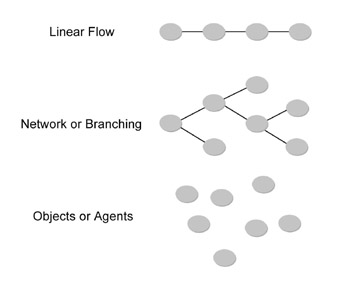
Figure 5.4: Various game structures
There’s no one correct way to design a game system, just as there’s no one type of game player. But you may find upon analyzing some of your favorite games that they share successful system designs in terms of the properties, behaviors, and relationships of their objects. Studying how the dynamics of these systems work can help focus your own thoughts and explorations.
Economies
Exercise 5.4: System Dynamics
Now let’s take the game you’ve been working with in Exercises 5.1, 5.2, and 5.3 and see how we can change the system dynamics by experimenting with the properties, behaviors or relationships of its core objects.
-
For example, if you chose a game like Monopoly, change the prices, placement and rent of every property on the board, or change the rules for movement. How you change these things them is up to you, but make significant changes.
-
Now, play the game. What happens? Did your changes affect the balance of the game? Is the game still playable?
-
If the system is still playable, make another change. For instance, take out all the “positive” Chance cards in Monopoly and leave in only“negative or neutral” cards. Play the game again. What happens?
-
Continue doing this exercise until the game is no longer playable.
What was the crucial change you made? Why do you think that change finally “broke” the game?
One important type of system structure often found in games is an economy. We’re going to look more closely at this structure because it involves dynamics surrounding the resources in a game, one of the fundamental formal elements of games.
What is an economy? As we touched on briefly in our discussion of the utility and scarcity of resources in Chapter 3, some games also allow for the exchange of resources—either with the system (i.e., the “bank” in Monopoly) or among players. When a game allows exchanges of this kind, the system of trade forms a simple economy. In more complex systems, the rules of real-world economies may apply, but more often, games have severely controlled economies that only vaguely resemble real-world markets. Even so, there are some basic concepts of economic theory that we can use as a barometer for the feasibility of our game economies.
First of all, to have an economy, a game must have items of exchange, such as resources or other barterable items; agents of exchange, such as players or the system bank; and methods of exchange, such as markets or other trading opportunities. Also, an economy may or may not have currency, which helps to facilitate trade. As in the real world, the methods by which prices are set in an economy depend on what type of market controls are in place. Prices of market items in games may be free, fixed or subject to a mixture of controls, depending on the design of the system. Also, the opportunities players have for trade can range from complete freedom to controls on prices, timing, partners, amount, etc. Here are some basic questions a designer should ask before building a game economy:
-
Does the size of the economy grow over the course of the game? For example, are resources produced, and if so, is the growth controlled by the system?
-
If there’s a currency, how is the supply of that currency controlled?
-
How are prices set in the economy? Are they controlled by market forces or set by the game system?
-
Are there any restrictions on opportunities for trade among participants; for instance by turn, time, cost or other constraints?
To get a sense for how games handle these economic variables, let’s look at some examples, ranging from classic boardgames to massively multiplayer online worlds.
Simple bartering
Pit is a simple card game in which players barter for various commodities in order to “corner the market.” There are eight suits of commodities, nine cards in each suit. The commodities are worth a varying number of points from 50–100. For example, oranges are worth 50 points, oats are 60 points, corn is 75, wheat is 100, etc. You start with the same number of suits in the deck as there are players—from three to eight. The cards are shuffled and dealt out evenly to all the players. During each round, players trade by calling out the number of cards they want to trade, but not the name of the commodity on the cards offered. Trade continues until one person holds all nine cards of a single commodity—a “corner” on that market.
There are several features to note in this simple barter system. First, the amount of product (i.e., cards) in the system is stable at all times—cards are not created or consumed during play. Additionally, the value of each card never changes relative to the other cards in the deck. The value is fixed by the printed point value set before the game begins. Also, the opportunity to trade is only restricted by number—all trades must be for an equal number of cards. Other than this, trade is open to all players at all times.
In this simple barter system, the in-game economy is so restricted by the rules of the game that there is no opportunity for economic growth, no fluctuation of prices based on supply and demand, no chance for market competition, etc. However, the trading system serves its purpose as an excuse for creating a frenetic, social trading atmosphere without any of the complexities of a real-world economy. To recap the features of this system:
-
Amount of product = fixed
-
Money supply = n/a
-
Prices = fixed
-
Trading opportunities = not restricted
Complex bartering
Settlers of Catan is a German boardgame by designer Klaus Teuber in which players compete as pioneers developing a new land. During the course of the game, players build roads and settlements that produce resources such as brick, wood, wool, rock, and wheat. These resources can be traded with other players and used to build more settlements and upgrade settlements to cities, which in turn produce more resources.
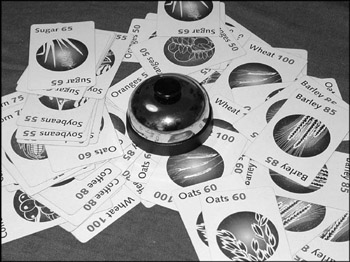
Figure 5.5: Pit
As in Pit, the bartering of resources is a central part of the gameplay, and the trade in this game is also fairly unrestricted—with the following exceptions:
-
You may only trade with a player on their turn.
-
Players can only trade resources—not settlements or other game objects.
-
A trade must involve at least one resource on each side (i.e., a player can’t simply give a resource away). However, trades can be made for unequal amounts of resources.
Other than these constraints, players can wheel and deal as they like for the resources they need. For example, if there is a scarcity of brick in the economy, players can trade two or three of another resource, such as wheat, for one brick.
As you can probably judge already, the economy of Settlers of Catan is much more complex than the simple barter system of Pit. One of the key differences is the fact that the relative values of the resources fluctuate depending on market conditions, an interesting and unpredictable feature that changes the experience of the game from play to play. If there is a glut of wheat in the game, the value of wheat falls immediately. On the other hand, if there is a scarcity of ore, players will trade aggressively for it. This simple example of the laws of supply and demand adds a fascinating aspect to gameplay that we did not see in the Pit example.
Another key difference from the simple bartering in Pit is that in Settlers of Catan the total amount of product in the economy changes over the course of the game. Each player’s turn has a production phase, the results of which are determined by a roll of the dice and the placement of player settlements. Product enters the system during this phase. Product is then traded and“consumed” (used to purchase road, settlements, etc.) during the second phase of the players turn.
In order to control the total amount of product in the system at any time, the system includes a punishment for holding too many resources in your hand. If a player rolls a seven during the production phase of their turn, any player holding more than seven cards has to give half of their hand to the bank. In this way, players are discouraged from hoarding, and encouraged to spend their resources as they earn them.
Another aspect of the economy that is interesting to note is the fact that while the barter system is fairly open, there is a control on price inflation. The bank will always trade 4:1 for any resource; this effectively caps the value of all resources. And, as we also noted, while the trading system itself is quite open, the opportunity to trade is restricted by player turn.
The last difference between these two barter systems is their information structures. In Settlers of Catan, players hide their hands, but the production phase is an open process, so by simply paying attention to which players are getting certain resources on each turn, an attentive player can remember some, if not all, of the game state.
-
Amount of product = controlled growth
-
Money supply = n/a
-
Prices = market value w/cap
-
Trading opportunities = restricted by turn
Exercise 5.6: Bartering Systems
For this exercise, take the simple barter game of Pit and add a new level of complexity to its trading system. One way to do this might be to create the concept of dynamically changing values for each of the commodities.
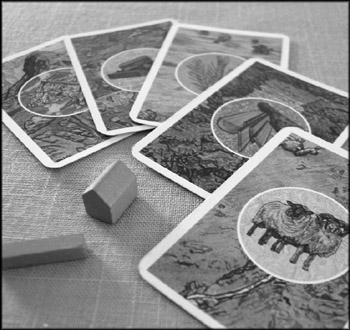
Figure 5.6: Barterable resources from Settlers of Catan
Simple market
The first two examples we’ve looked at have both been barter systems (i.e., they didn’t employ currency). The next type of system we’ll look at is the simple market system of Monopoly. In Monopoly, players buy, sell, rent, and improve real estate in an attempt to become the richest player in the game. The real estate market in the game is finite—there are 28 properties in the market (including railroads and utilities) at all times. Although propertiesaren’t sold until a player lands on their board space, they are still active in the sense that they are available for purchase.
Each player begins the game with $1,500 from the bank, which they can use to purchase properties or pay rent and other fees. The growth of the economy is controlled by the rate at which players can circle the board, passing “go” to collect $200. According to the official rules, the bank never goes broke; if it runs out of money, the player acting as banker can create new notes out of slips of paper.
In terms of trading opportunities, the rules state that buying and trading of properties between players can occur at any time, although “etiquette suggests that such transactions occur only between the turns of other players.”[3]
Values of properties in the game are set in two basic ways. First, there is the face value on the title deed; if a player lands on a property, she may purchase it for this amount. If she fails to purchase the property, it goes up to auction and sells to the highest bidder. The auction is not limited by the face value, and the player who passed up purchasing it may bid in the auction. Once a property is purchased, it may be traded between players at any price they agree upon. So, the second and more important value of properties in the game is a true market value set by the competition of the players.
-
Amount of product = fixed
-
Money supply = controlled growth
-
Prices = market value
-
Trading opportunities = not restricted
Complex market
For examples of complex market economies, we’ll look at two games: Ultima Online and EverQuest. The two economies have much in common overall, but different emphases in their designs have created unique situations for each system. The key similarity in these and other online worlds is the fact that they have persistent economies that surpass a single game session by any one player. This immediately puts them in a category of complexity far beyond all the other examples we have looked at so far. The assumption often is that because of the persistence of economy in these games and because they strive to create a sense of an alternate world, that real world economics apply directly to their systems.

Figure 5.7: Monopoly money and property
In both games, players create characters, or avatars, which begin the game with a small number of resources—a little gold in Ultima or platinum in EverQuest, some minimal armor and a weapon. Now players must enter the “labor market” to gain more resources. In both games, players begin at the lowest level of the labor market—killing small animals or doing other menial work to earn money. They can sell the results of their labor to system agents (in the form of shopkeepers) or to other players, if they can find interested buyers. In addition to the labor market, players can find, make, buy, or sell more complex items than those gained by labor. Items like weapons, armor, and magic items are part of a complex “goods” market.
In both games, goods and labor are traded in two ways: player to player, and player to system. In both games, player to system trade, controlled by the game designers, exists to keep low-level “employment” steady while encouraging the player to player trade in scarce items. For example, shopkeepers will generally buy anything a player wants to sell—even if there is a glut of the object in the market. This keeps newbies steadily“employed.” On the other hand, the shopkeepers’ offers to buy on higher-level items will not be as competitive as the player to player market, encouraging players to seek out higher prices from one another.
In this way, the games create markets that mimic real-world situations in important ways, and contradict real-world expectations in others. Supply and demand is a factor for players dealing at higher levels of commerce, with scarce or unique items, but it is not a factor for a newbie just trying to get ahead.
The amount of product in the system is controlled by the game designers—although Ultima at first tried to create a self-regulating flow in which resources were recycled through the system, available to re-spawn as new creatures and other materials as they were “spent” by the players. This was quickly changed to a system in which the flow of resources into the economy could be directly controlled by the designers. There were several reasons for this, one of which was a tendency for players to “hoard” game objects, restricting the total amount of products circulating in the game.
In both games, a “meta economy” has emerged separate from official gameplay in which characters and game objects are sold between players in real-world markets. Characters have been offered on sites such as eBay and Yahoo! Auctions, sometimes selling for hundreds of dollars, depending on the level and inventory offered. While this meta economy was not a planned feature of these role-playing games, there are games that have included the concept of a meta economy in their designs.
Alan Moon is a prolific designer of board and card games. His games are particularly popular in Europe.
Title: Game Designer
Project list (five to eight top projects)
-
Elfenland: Spiel des Jahres (German Game of the Year) 1998
-
Das Amulett: Spiel des Jahres nominee 2001
-
Union Pacific: Spiel des Jahres nominee 1999
-
Capitol: Spiel des Jahres selection list 2001
-
San Marco: Spiel des Jahres selection list 2001
-
Reibach & Co.: Spiel des Jahres selection list 1996
-
dozens of other board and card games
How did you get into the game industry?
I was hired by the Avalon Hill Game Co. in Baltimore to takeover as editor of their house magazine called The General. But I never really assumed that job, because when I got to Avalon Hill I started working on developing games. I loved working on games, hated editing. After working as a developer, I also started designing games. Four years later, I left Avalon Hill to go to Parker Brothers in Beverly, Massachusetts as a designer in their video division.
What are your five favorite games and why?
-
Spades: Best partnership card game ever invented. Endlessly fascinating. Even if you are dealt the worst hand possible, you must still play it well and use it to score as many points a possible.
-
Hunters & Gatherers (second Carcassonne game by Hans im Glueck): On your turn, you draw a tile and play it, and then you can place one of your Meeples or not. That’s all you do. But the game is constantly tense and exciting. Every game is different and you always feel like you can win right up until the end.
-
Adel Verpflichtet (originally F.X. Schmid and Avalon Hill, now ALEA and Rio Grande): Sort of advanced “rock, paper, scissors.” Each turn, the five players initially choose one of two locations, dividing themselves into two groups. Then the players in each group compete against each other. The ultimate game about player tendencies and psychology. You have to learn to play against your natural inclinations or you’ll become too predictable. Gets better and better the more you play with the same people.
-
Liars Dice / Bluff (originally Milton Bradley & F.X. Schmid, now Ravensburger and Endless Games): A dice version of the game gamblers play with dollar bills. The dice just provide the mechanic though, as there is little or no luck involved.
-
Crokinole (Generic): Never thought I’d like an action game or a flicking game. But this one is totally addictive. Most people get better with practice too, which makes the game rewarding as well as fun.
What games have inspired you the most as a designer and why?
When I was a kid, my family played games every Sunday. I can still remember games of hearts, Risk, and Facts in Five. Hearts and bridge were the foundation for my love of card games, which has grown ever since. My friend Richard Borg described the fascination if cards the best when he said, “Every five or ten minutes you get a new hand, a new chance to get that all-time best hand.” Risk led to more complex historical simulations, most published by Avalon Hill. European games retain the strategy and decision making of these more complex games, but add the social element of multiplayer, more interactive games, and that is what really keeps me playing and designing games. But if I had to pick one game that inspired me the most, it would be Acquire by Sid Sackson. Sadly Sid died last year, but he will always be the dean of game designers. My first big boardgame Airlines (Abacus, 1990) was inspired by Acquire.
What are you most proud of in your career?
I guess I’m proud of all the friends I’ve made through games, and the network of contacts I’ve built up in the toy and game industry. I may never be wealthy, but I’ll always be rich in friends. But someday, I hope to be proud of the best game I’ve ever designed. It just hasn’t happened yet.
What words of advice would you give to an aspiring designer today?
Play as many games as you can. It’s research. It’s the only way you learn. You can’t design games in a vacuum, without knowing what has already been done, what’s worked, and what hasn’t worked. The idea for almost all games comes from other games. Sometimes you play a bad game with one good idea. Sometimes you play a good game and find a new twist to a good idea. Keep playing. Keep designing. Be confident, but remember that there is always more to learn. Like everything, you’ll get better with practice. It took me fourteen years to have any real success as a designer. Those fourteen years were tough, but they were worth it.
Playtest your designs as much as possible. Develop a core group of playtesters. You also need to learn when it’s time to let something go and work on something else, and when you should keep plugging even though it doesn’t seem like the game is ever going to work. Being a game designer is much more than just being creative. You need to be organized, thorough, and flexible. You’ll also need to be a good salesman because designing a game is just half the battle. You still have to sell it to someone after that.
-
Amount of product = controlled growth
-
Money supply = controlled growth
-
Prices = market value w/base
-
Trading opportunities = not restricted
Meta economy
Magic: The Gathering is somewhat different from the other example games we’ve looked at, in that the game itself does not include a trading or exchange component. The main system of Magic is a dueling game, in which players use custom- designed decks of cards to battle each other. These cards, purchased by individual players, form the central resource in a “meta economy” surrounding the game itself.
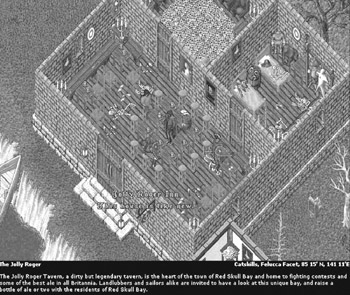
Figure 5.8: Player-run establishment in Ultima Online
Magic: The Gathering was designed by Richard Garfield and released by Wizards of the Coast, a Seattle-based game company, in 1993. At the time, Garfield was a mathematics professor at Whitman College as well as a part-time game designer. Wizards asked him to design a card game that was quick, fun, and playable in under an hour. But Garfield imagined a game that had the collectible nature of trading cards or marbles, combined with the qualities of Strat-O-Matic Baseball—in which players draft and compete their own teams. The result was a collectible card game that has been likened to “gaming crack.”
As mentioned, the game Garfield designed is a two-player dueling game with a fantasy theme. Each player has a deck of cards that consists of various spells, monsters, and lands. Land provides mana, which powers spells. These spells summon monsters that you use to attack your opponent. This would seem pretty straightforward, except for the fact that a basic deck of game cards doesn’t include all the cards in the system. In fact, it contains a mere fraction of the cards available. Players are encouraged to buy booster sets, and to upgrade their deck as new revisions are released. And, important to our discussion of game economies, players can also buy and trade cards from each other, which they do aggressively. The market for Magic cards, and other similar trading game cards, is worldwide, now greatly facilitated by the Internet.
The publisher of the game has control of the overall shape of this economy, in that they gauge how many cards to release—some cards are very rare, some are just uncommon, and others are not valuable at all, because there are simply far too many of them available. But the publisher has no control over where and how these cards are traded, once they have been purchased; and, other than rarity, they have no control over the prices set for these game objects.
In addition to the collectible nature of Magic, and the meta economy formed by the trade of its game objects, there is an in-game aspect to this meta economy. Players choose cards from their collection to build decks, adjusting the amount of land, the type of creatures and spells in order to strike a winning balance.
This process of building and testing decks for effectiveness is similar to the process a game designer would go through when testing the balance of their system, and, of course, the designers of Magic do work hard to make sure that any single cards or combinations of cards are not so overpowered as to imbalance the game. But the final decisions regarding resource balance are left in the hands of the player, and are highly affected by the meta economy surrounding the game.
The openness of the Magic system, and its success as a business as well as a game, has spawned a whole genre of trading games. As with the current interest in online worlds, it’s clear that much of the success of these future games will depend on how their in-game and metagame economies are managed over time.
-
Amount of product = controlled growth
-
Money supply = n/a
-
Prices = market value
-
Trading opportunities = not restricted
As you can see, there are a wide variety of economies, ranging from simple bartering to complex markets. The task of the designer is to wed the economic system with the game’s overall structure. The economy must tie directly into the player’s objective in the game and be balanced against the comparative utility and scarcity of the resources it involves. Every action the player performs in relation to the economic system should either advance or hinder their progress in the game.
Emergent systems
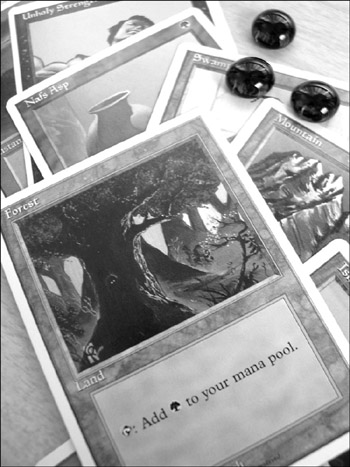
5.9 Magic: The Gathering cards
Economies have the potential to transform rudimentary games into complex systems, and if you’re creative, you can use them as a way to get players to interact with one another. There’s nothing better for community building than an underlying economy, which makes socializing into a game.
Developing new types of in-game economies is one of the areas in which modern game design has just begun to explore the potential. Even with the success of EverQuest, we’re just beginning to understand the power of these systems. The fusing of economic models and social interaction is one of the most promising areas for future game experimentation, and in the next decade, we will see new types of Internet-based games emerge that challenge our conception of what a game can be.
We’ve talked about how game systems can display very complex behaviors when set in motion. But this doesn’t mean that their underlying systems must be complex in design. In fact, in many cases, simple rules, when set in motion, can beget complex results. Nature is full of examples of this phenomenon, which is called “emergence.”
An individual ant is a simple creature—capable of very little by itself and living its life according to a simple set of rules. However, when many ants interact together in a colony, each following these simple rules, a spontaneous intelligence emerges. Collectively the drone ants become capable of sophisticated engineering, defense, food storage, etc. Similarly, some researchers believe that human consciousness may be a product of emergence. In this case millions of simple “agents” in the mind interact to create rational thought. The topic of emergence has spawned dozens of books exploring links between previously unconnected natural phenomena.
One experiment in emergence, which is interesting for game designers, is called the Game of Life. (No, it’s not related to Milton Bradley’s boardgame The Game of Life.) This experiment was conducted in the 1960s by a mathematician at Cambridge University named John Conway. He was fascinated with the idea that rudimentary elements working together according to simple rules could produce fantastic results. He wanted to create an example of this phenomenon so simple that it could be observed in a two-dimensional space like a checkerboard.

Figure 5.10: R Pentomino over several generations
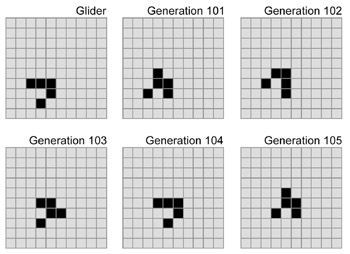
Figure 5.11: Glider “walk” cycle
Building on the work of mathematicians before him, Conway toyed with rules that would make squares on the board turn “on” or “off” based on their adjacency to the other squares around them. Acting very much like a game creator, he designed, tested, and revised different sets of rules for these cells for several years with several associates in his department at Cambridge.
Finally he arrived at this set of rules:
-
Birth: if an unpopulated cell is surrounded by exactly three populated cells, it becomes populated in the next generation.
-
Death by Loneliness: if a populated cell is surrounded by fewer than two other populated cells it becomes unpopulated in the next generation.
-
Death by Overpopulation: if a populated cell is surrounded by at least four other populated cells it becomes unpopulated in the next generation.
Conway and his associates set Go pieces on a checkerboard board to mark populated cells and administered the rules by hand. They found that different starting conditions evolved in vastly different ways. Some simple starting conditions could blossom into beautiful patterns that would fill the board and some elaborate starting conditions could fizzle into nothing. An interesting discovery was made with a configuration called R Pentomino. Figure 5.10 shows the starting position for the R Pentomino, followed by several generations.
One of Conway’s associates, Richard Guy, kept experimenting with this configuration. He administered the rules for a hundred generations or so and watched a mishmash of shapes appear. Then, suddenly a set of cells emerged from the group and appeared to “walk” on it’s own across the board. Guy pointed out to the group, “Look, my bit’s walking!”[4] Guy worked on the configuration until it “walked” across the room and out the door. He had discovered what the group would call a “glider.” A glider is a configuration that cycles through a set of shapes and moves along the board as it goes. Figure 5.11 shows what several generations of Guy’s glider look like.
Conway’s system was dubbed the Game of Life, as it showed that from simple beginnings lifeform-like patterns could develop. There are a number of emulators online that you can download and experiment with. You’ll see that some use different rules and allow you to create your own starting conditions.
Emergent systems are interesting to game designers because games can employ emergent techniques to make more believable and unpredictable scenarios. Games as different as The Sims, Grand Theft Auto 3, Halo, Black & White, Pikmin, Munch’s Oddysee, and Metal Gear Solid 2 have all experimented with emergent properties in their designs.
One recent example is the character AI in Halo. Nonplayer characters have three simple impulses that drive them: (1) perception of the world around them (aural, visual, and tactile), (2) state of the world (memories of enemy sightings and weapon locations) and (3) emotion (growing scared when under attack, etc.).[5] These three sets of rules interact—each consulting the other—as a decision-making system in a character. The result is semirealistic behavior within the game. The noncharacters do not follow a script written by a designer but rather make their own decisions based on the situation they’re in. For instance, if all of their friends have been killed and they’re facing overwhelming firepower from the enemy, they tend to run away; otherwise, they stay and fight.
Different games utilize different methods for creating emergent behavior. The Sims embeds simple rules in both the characters and in items in the environment. Will Wright, creator of The Sims, built the household items in the game to have values. When a character gets near an item—such as a bed, refrigerator, or pinball machine—the rules in the character interact with the rules in the items. So if a character’s rules say he’s sleepy, then an item that provides comfort, such as a bed, may attract his attention.
All of the previous examples share the same basic concept that simple rules beget complex behavior when interacting within a system. This concept is an exciting and fast moving aspect of games today, and it’s wide open to experimentation and innovation.

Figure 5.12: The Sims
[2]Some chess texts and programs use different values for the various pieces. This is the standard value given by most texts.
[3]Parker Brothers, Monopoly Deluxe Edition rules sheet, 1995.
[4]William Poundstone, Prisoner’s Dilemma (New York: Doubleday, 1992)
[5]Steven Johnson, “Wild Things,” Wired issue 10.03.
|
| < Day Day Up > |
|
EAN: 2147483647
Pages: 162